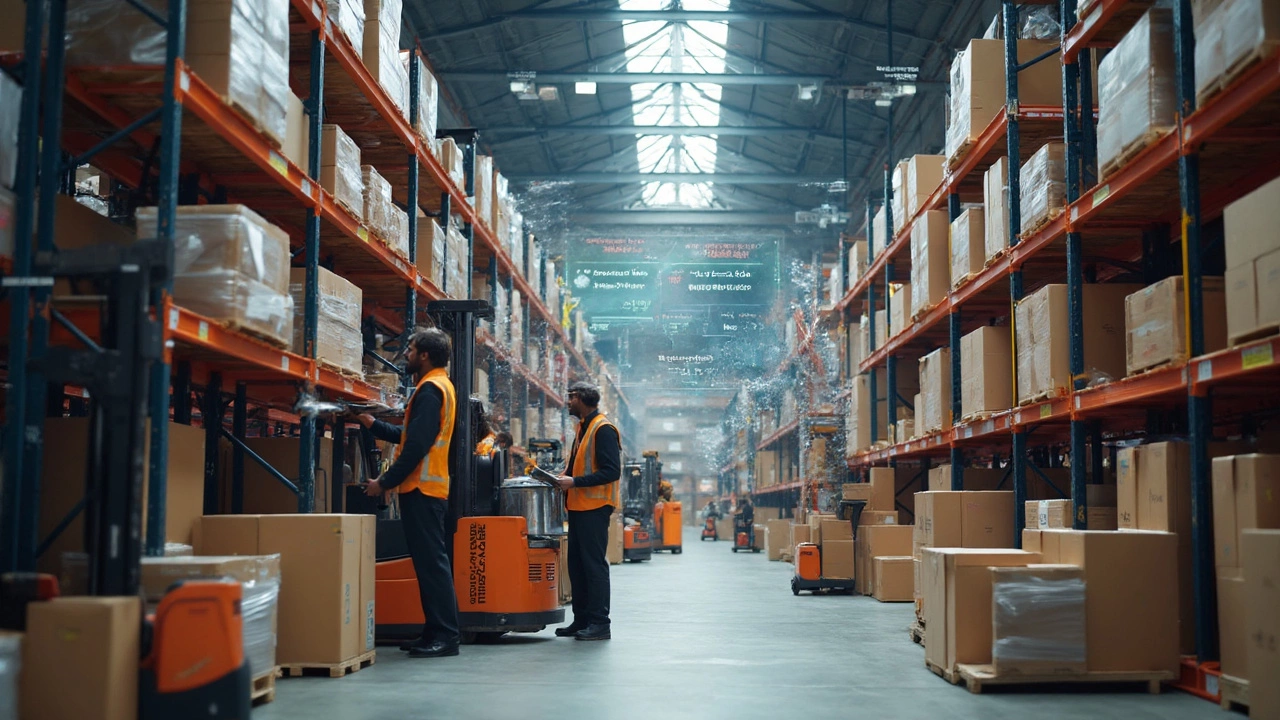If you've ever tracked a package and wondered how it magically makes it from a giant warehouse to your front door, you're thinking about logistics systems in action. Every product—whether it's your kid's soccer cleats or a new phone—travels through a behind-the-scenes maze handled by these systems. But what exactly is going on back there? At the heart of logistics, there are three main jobs: inventory management, transportation, and order processing. They’re not just buzzwords. Mess up one, and you get late deliveries, annoyed customers, or even empty shelves.
Most businesses, from small online sellers to big retailers, rely on logistics software to juggle these activities. Good software keeps tabs on stock, tracks trucks, and makes sure every order lands where it should, fast. It's the secret sauce that prevents chaos, especially when demand spikes—like when Tobias’ favorite Pokémon cards were suddenly impossible to find last Christmas. So if smooth deliveries and happy customers matter to you, knowing these three core activities can make a real difference.
- What Are Logistics Systems?
- Inventory Management: Keeping Stock Flowing
- Transportation: Getting Goods from A to B
- Order Processing: Fast and Accurate Every Time
- Tips for Better Logistics with Software
What Are Logistics Systems?
Logistics systems are the backbone of getting stuff from where it’s made to where it needs to go—whether that’s a warehouse, a retail store, or right to your doorstep. Think of them like the invisible team making sure you never open your fridge to find it empty because the delivery didn’t happen. These systems are used by grocery chains, e-commerce giants, car makers, and even small local shops. That’s how widespread and important they are.
At the center of this whole thing is logistics software. This software connects all the dots—products, storage, transportation, and customers—in one place. It takes raw data about supplies, orders, and shipments and turns it into steps people can actually follow. Without it, keeping track of hundreds or thousands of orders gets messy super fast.
A solid logistics system covers three big areas:
- Inventory management: Making sure the right amount of the right product is always in stock.
- Transportation: Planning the best routes and schedules to move goods smoothly and affordably.
- Order processing: Turning customer orders into actual shipments, error-free and on time.
The coolest part? The best systems update in real time. So, if three people all order the same limited-edition sneakers at once, the system knows exactly when to stop taking new orders. That saves brands from angry emails or the headache of refunds. Simple mistakes like shipping the wrong color or missing a delivery window cost money and trust—automated logistics cut those risks way down.
Whether you’re shipping baked goods across town or gadgets worldwide, the same basic system keeps everything on track. Good logistics systems save money, reduce waste, and keep both businesses and customers happy. That’s not just good business sense—it’s what keeps modern life running smoothly, often without us even noticing.
Inventory Management: Keeping Stock Flowing
Ever open the pantry and realize you’re out of your kid’s favorite snack? Now imagine that on a huge scale—a whole store, or worse, a warehouse. That’s why inventory management stands at the core of any logistics system. It’s all about knowing exactly what you have, where it is, and when you’ll need more. The goal? To make sure you don’t run out of stuff that sells or get stuck with piles of things nobody wants.
The right logistics software takes away the guesswork. Real-time inventory tracking lets businesses see their stock across all locations, whether it’s on the shelf or still on a truck. Companies like Walmart and Amazon have turned this into a science, using software to predict which products will fly off the shelves and which can chill for a bit. Automated systems even send alerts when stock is running low or when something’s not selling fast enough.
Good inventory management software can:
- Sync inventory across stores and warehouses, reducing errors
- Forecast demand, so you only order what you’ll actually sell
- Flag slow-moving products before they take up valuable space
- Track expiration dates, especially important for food or medicine
Pro tip: Barcode scanners and RFID tags are total game-changers. They cut out manual entry mistakes and make it way easier to monitor stock levels in real time. Don’t rely on spreadsheets—mistyped numbers can cost you thousands and frustrate your customers.
The best part? When your inventory is healthy, your cash flow is healthier. You avoid tying up money in dead stock, and you can jump on new trends without worrying about old leftovers clogging up space. That’s a win for any business that cares about staying ahead.

Transportation: Getting Goods from A to B
Moving things from point A to point B sounds simple—until you realize there are thousands of shipments happening at once, all with tight deadlines. Transportation in logistics covers every method used: trucks, ships, trains, and planes. It’s the stage where supply chain plans become reality. Pick the wrong carrier, route, or timing, and suddenly products are stuck, costs skyrocket, or customers get frustrated. That’s why many companies turn to modern logistics software for help.
Let’s get practical. The cost of transportation usually takes up more than half the logistics budget. According to the Council of Supply Chain Management Professionals, almost 56% of total U.S. logistics costs in 2024 went straight to transportation. The right software not only manages shipments but helps compare carriers, plan routes, and find ways to fill trucks efficiently—cutting down on unnecessary trips and saving money.
Here’s how software boosts transportation:
- Real-time tracking: Most tools let you track every shipment on a map, so you always know where your goods are and when they’ll arrive. No more guessing—or making awkward apology calls to customers.
- Route optimization: Good systems look at traffic, weather, and delivery urgency to plan the fastest, cheapest routes. If roads are closed or weather gets nasty, they suggest workarounds automatically.
- Carrier selection: You get rate comparisons and reliability stats for different transport companies, making it easy to pick the best one on the fly.
- Automated paperwork: The headache of bills, customs forms, and delivery receipts turns into a few clicks, not hours of paperwork. No more lost forms, either.
Take a look at some sample data showing how different transportation modes perform:
| Mode | Average Speed (mph) | Typical Cost per Mile (USD) | Recommended For |
|---|---|---|---|
| Truck | 60 | 2.50 | Short/medium hauls, flexible delivery |
| Train | 50 | 1.20 | Bulk goods, long distances |
| Ship | 20 | 0.16 | International, heavy goods |
| Air | 500 | 10.00 | Urgent, high-value items |
One tip: Mix and match. Many companies use a combo approach—a truck picks up from the factory, hands things off to a train or ship for the long haul, and another truck handles final delivery. Logistics software pieces together these segments like a puzzle, making the whole journey smooth and cost-effective. If you’re running a business, ask your software vendor about multi-modal options and real-time alerts. It’s a small thing that can save you a ton of stress—and cash—down the line.
Order Processing: Fast and Accurate Every Time
Order processing is the make-or-break stage in any logistics setup. Basically, it’s what happens between someone clicking “Buy Now” and the moment their package hits the road. Every second and detail count. If you mess up here, it’s game over for customer satisfaction and repeat business. In fact, a 2023 Shopify report found that 72% of online shoppers expect their orders to be accurate, and nearly half will ditch a retailer forever after one mix-up.
So, what actually happens behind the scenes?
- Order entry: As soon as an order comes in, it’s logged in the logistics software. No more manual paperwork, and way fewer mistakes.
- Picking: Workers (or robots—yep, those are real now) find the right products in the warehouse. Some companies, like Amazon, use barcode scanners to speed this up and catch errors right away.
- Packing: Each item gets packed up, with shipping labels and invoices printed automatically by the system.
- Shipping: The software schedules a pickup, matches orders with the best carriers, and updates delivery estimates for customers instantly.
Here’s a real eye-opener: According to Statista, automated order processing can cut fulfillment times by up to 50%. That’s huge if you’re dealing with big sales spikes or must-hit deadlines (hello, holiday shopping rush!). The trick is to connect all your systems—orders, inventory, and shipping—so nothing slips through the cracks.
Want to see how speed and accuracy really stack up? Check out this comparison from warehouse industry research:
| Order Processing Method | Average Processing Time (minutes) | Error Rate (%) |
|---|---|---|
| Manual (Paper-Based) | 25 | 3.4 |
| Semi-Automated (Spreadsheet) | 15 | 2.1 |
| Fully Automated (Logistics Software) | 8 | 0.8 |
If you want fewer mix-ups and faster shipping, automation is the way forward. Double-check those integrations between your order system and warehouse tools. Even small upgrades—like adding barcode readers or smarter packing apps—can save hours every week. And always make sure tracking info is updated in real time. Customers love it when they know where their package is—my son Tobias will refresh a delivery tracking page ten times in one afternoon!

Tips for Better Logistics with Software
Nailing logistics isn’t just about moving boxes—it’s about using smart tools to make everything run smoother. The right logistics software helps you ditch spreadsheets and sticky notes for good. But what should you really look for, and how do you make the most out of these tools? Here’s what works in the real world.
- Pick all-in-one platforms: A system that covers everything—inventory, transportation, and orders—means less switching between tabs and fewer mistakes. One dashboard equals less chaos and fewer chances for something to slip through.
- Automate where you can: Modern software can automatically update stock levels, send tracking links, and trigger reorder alerts when supplies get low. This cuts down on errors from manual entry and keeps you from running out at the worst moment.
- Use real-time tracking: Knowing exactly where your shipments and inventory are at any minute lets you spot problems fast. Tools like barcode scanners or RFID tags feed data right to your screen, so you aren’t stuck waiting for an update. Some platforms even offer instant notifications if a delivery falls behind schedule.
- Integrate with what you already use: The best logistics software plays nicely with your current sales platforms, accounting software, and even customer service apps. Integration saves time and lowers the risk of losing orders or double-booking inventory.
- Dig into analytics: Most systems come loaded with reports showing things like average delivery times, return rates, and which products sell out fastest. Use these insights to spot bottlenecks and plan for crazy order surges, so you’re ready before the rush hits.
One quick tip: make sure the software you choose has solid support and easy tutorials. Even the fanciest platform won’t help if your team avoids using it because it’s confusing. When you get everyone on board and automate the basics, your whole supply chain gets faster, more accurate, and way less stressful.





